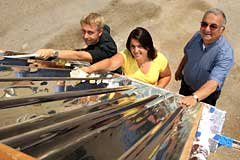Aug 15 2009
As the world's hunger for energy grows and fossil fuel supplies become less certain, the need to develop alternative renewable energy sources is paramount. The most abundant source of renewable energy is the sun.
 Roland Winston (right) heads the California Advanced Solar Technologies program.
Roland Winston (right) heads the California Advanced Solar Technologies program.
However, current technology used to convert sunlight into electricity is still relatively costly for wide-scale use. The solution? Find ways to make solar energy more efficient and cheaper to utilize.
Researchers at the University of California, Merced, and its sister campuses in Berkeley and Santa Barbara will attempt to do just that using nanotechnology and non-imaging optics to develop new solar cell materials, thanks to a five-year $2.25 million grant that will fund a new UC-wide solar energy research program.
California Advanced Solar Technologies (CAST) is one of 37 multicampus research programs and initiatives that received funding from the UC Office of the President.
CAST will serve as a platform for a variety of solar energy projects. Leading the program is Roland Winston, UC Merced professor and CAST director. A founding faculty member who is a presidential endowed chair in the schools of Engineering and Natural Sciences, Winston invented the field of non-imaging optics. He has received numerous awards for his research in this area and its applications to the solar energy field.
Also participating in CAST is assistant professor Sayantani Ghosh of the School of Natural Sciences. Additionally, all UC Merced faculty members with related research interests are welcome to participate.
"Professor Winston and his colleagues are to be congratulated as competition for this funding was extremely fierce," said Samuel J. Traina, vice chancellor for research and dean of graduate studies. "UC Merced welcomes the opportunity to help find solutions to advance the development of solar energy technologies."
Some of the broad categories CAST researchers will cover include development of novel photovoltaic devices, which convert sunlight into electricity, and thermal energy for cooling of buildings, industry and other applications. Winston has developed devices that can harness sunlight and multiply the energy by almost 100,000 times more than its natural level.
"UC Merced's location in the San Joaquin Valley provides many ideal settings for the development and utilization of solar energy," Winston said. "Solar energy is, by far, the most abundant of all renewable energy resources and development of technologies to harness and use that resource is an important topic for California and the world."
In addition to speeding the commercialization of solar technologies, another of CAST's primary goals is to help train the next generation of solar energy researchers. Researchers from the three participating UC campuses will meet quarterly to discuss projects, conduct site visits and work collaboratively on device development, fabrication and testing.
UC Merced's participation in CAST is another example of how the newest research university of the 21st century is using interdisciplinary collaborations to find solutions to world problems. Read more on UC Merced's sustainability and energy projects and goals.